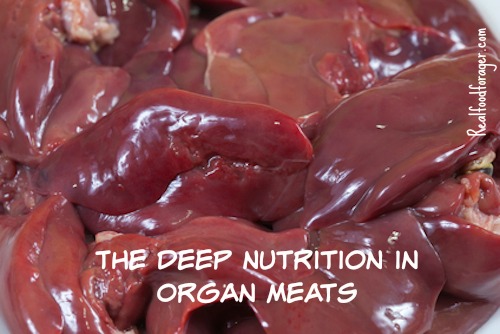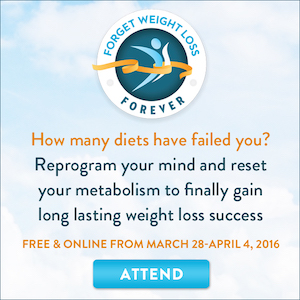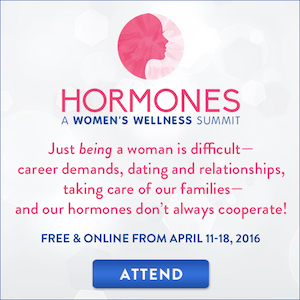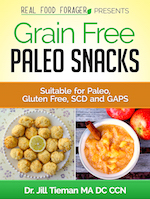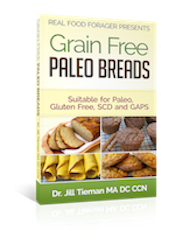Whenever I suggest to my patients that they should be eating organ meats I get that look of disbelief that says – are you kidding? I thought organ meats are full of toxins and saturated fat?!? This was exactly my reaction years ago until I found out the truth.
The truth is that organs do not store toxins. Yes, they filter toxins, especially the liver and kidneys, but the main purpose of these organs is to detoxify the potentially harmful byproducts of digestion and other metabolic reactions. The toxins are neutralized in these organs and passed out of the body.
What they do store are the critically important fat soluble vitamins, A, D, E and K2.
In fact, liver in the most potent source of vitamin A. It’s no wonder that so many people are deficient in vitamin A – very few of us eat liver these days.
Liver has been given a bad rap. Yes, it is full of cholesterol, but if you’ve been reading some of my posts about cholesterol you know that cholesterol is not the bad guy. Cholesterol is an innocent bystander and actually a healing compound.
Nutrient Dense
The words nutrient dense are thrown around and attributed to various “super foods” like kale and other green leafy vegetables. Yes, these green leafy vegetables have a lot of important minerals, but as far as fat soluble vitamins go, they are not nutrient dense at all.
Additionally, you need to eat fat along with the green leafys (and other vegetables) in order to extract the minerals. That’s why, traditionally, vegetables were served smothered in butter! Butter (and other fats) contains the important fat soluble vitamins A, D, E and K2 which are necessary for mineral absorption.
Vitamin A and Beta Carotene are Not the Same
There is a belief that beta carotene, the precursor to vitamin A, falls under the category of nutrient dense. However, a high intake of beta carotene does not ensure that you are getting enough vitamin A.
Vitamin A is actually a group of compounds called retinoids. Retinol is the most common form. This is stored in the liver.
Vitamin A is essential for strong bones, a strong immune system and good eyesight (as rhodopsin) and critical for other metabolic reactions.
Vitamin A is often measured in international units (iu), and the Institute of Medicine recommends a daily intake of 3,000 international units for men and 2,310 for women, with slightly more during pregnancy and about 4,000 during breast-feeding.
Beta carotene is also known as provitamin A because your body can convert it to vitamin A. Many people think that just having enough beta carotene available will provide vitamin A when needed.
Let me address that myth here.
In order to convert beta carotene to vitamin A you need to have the specific enzyme in your small intestine available to cleave it into two molecules of retinol. If you are deficient in that enzyme, or lacking some of the minerals or co-enzymes necessary, you will not convert beta carotene to vitamin A effectively.
Other factors influencing conversion of beta carotene to vitamin A include, intestinal health, available bile salts in the intestine and the amount of dietary fat in the intestines. Because retinol is a fat-soluble vitamin it needs some fat to be absorbed and stored in the body. Here again, eating good quality fat helps absorb nutrients.
Children and people who have any intestinal dysfunction may have trouble converting beta carotene to vitamin A.
Additionally, the conversion and absorption efficiency of retinol is relatively low — between 9 percent and 22 percent, or essentially a six to one ratio of beta carotene to retinol which further depends on the many factors stated above.
Furthermore, there are many other factors that influences your conversion rate such as, medications that may interfere, if you are eating processed and fast foods, if you drink excessive alcohol, the effects of pesticides and stress and if you follow a low fat diet.
Clearly, the vegetarians and vegans who are depending on beta carotene for their vitamin A are in for a sobering truth. It would take eating a ton of vegetables each day to make up for the poor conversion rate, the conventional guidelines that support using ketchup and canned tomato soup as sources not-with-standing.
Liver is the Best Food Source of Retinol
Liver from a clean, pasture raised animal is the very best food source of vitamin A. (Cod liver oil is also a powerful source of vitamin A and should be consumed every day as insurance.)
In addition to the highest food source of vitamin A, liver is full of just about every nutrient, including high amounts of vitamins B1, B2, B6, folic acid and importantly vitamin B12. Organ meats in general are also loaded with minerals like phosphorus, iron, copper, magnesium, iodine, calcium, potassium, sodium, selenium, zinc and manganese in forms that are easily absorbed.
Additionally, kidneys are full of vitamin B12, selenium, iron, copper, phosphorus and zinc. Although technically heart is a muscle, it is considered an organ and it is very high in Co-enzyme Q10, a critical molecule for heart health.
As noted, liver and other organs are loaded with the critically important fat-soluble vitamins A, D, E and K. Organ meats are known to have some of the highest concentrations of naturally occurring vitamin D of any food source.
Surprisingly, organ meats also contain high amounts of essential fatty acids, including arachidonic acid and the omega-3 fats EPA and DHA when it is from an animal raised on grass.
These nutrients are all sourced as a whole food, surrounded by all the co-factors necessary for proper digestion and assimilation. You just can’t get all this in a synthetic pill.
The studies that show vitamin A to be toxic were all performed with synthetic vitamin A. That simply doesn’t happen in nature.
My mother made liver once a week. It was not something I looked forward to as she was not a very good cook. Likely, it was overcooked and dry. There are a few tricks to make liver much more palatable and even a desired part of the meal or a meal unto its own.
Click here for my recipe for Chicken Liver Pate and a few tips and tricks that will have your family asking for more!
In the words of Sally Fallon Morrel and Dr. Enig,
Doctors of a generation or two ago understood that a diet rich in vitamin A from liver, eggs, butter, cream and cod liver oil was the best possible protection against birth defects. (source)
Are you convinced yet? Do you eat liver or organs? Leave a comment and let me know!
If you live on Long Island, check out News12 today. I’m featured in Long Island Naturally with Mary Mucci and we are making chicken liver pate!

